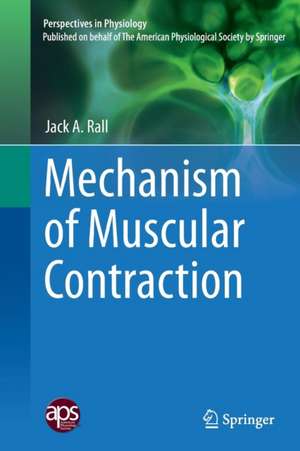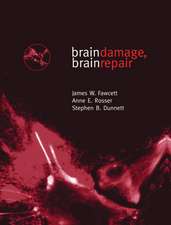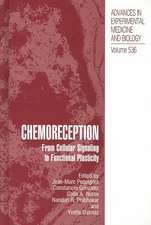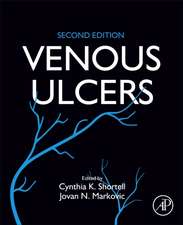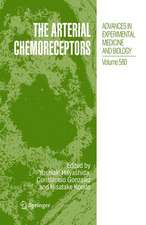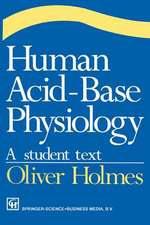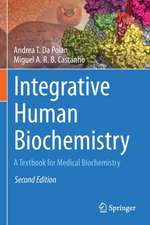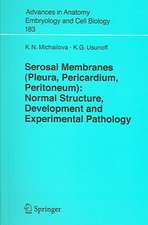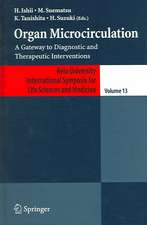Mechanism of Muscular Contraction: Perspectives in Physiology
Autor Jack A. Rallen Limba Engleză Paperback – 23 aug 2016
The pathway to ATP and the high energy phosphate bond will be discussed, as well as the discovery of myosin, contraction coupling and the emergence of cell and molecular biology in the muscle field. Numerous figures from original papers are also included for readers to see the data that led to important conclusions.
This book is published on behalf of the American Physiological Society by Springer. Access to APS books published with Springer is free to APS members.
Preț: 915.41 lei
Preț vechi: 963.59 lei
-5% Nou
Puncte Express: 1373
Preț estimativ în valută:
175.16€ • 183.37$ • 144.94£
175.16€ • 183.37$ • 144.94£
Carte tipărită la comandă
Livrare economică 05-19 aprilie
Preluare comenzi: 021 569.72.76
Specificații
ISBN-13: 9781493943364
ISBN-10: 1493943367
Pagini: 484
Ilustrații: XIII, 471 p. 179 illus., 34 illus. in color.
Dimensiuni: 155 x 235 x 25 mm
Greutate: 0.68 kg
Ediția:Softcover reprint of the original 1st ed. 2014
Editura: Springer
Colecția Springer
Seria Perspectives in Physiology
Locul publicării:New York, NY, United States
ISBN-10: 1493943367
Pagini: 484
Ilustrații: XIII, 471 p. 179 illus., 34 illus. in color.
Dimensiuni: 155 x 235 x 25 mm
Greutate: 0.68 kg
Ediția:Softcover reprint of the original 1st ed. 2014
Editura: Springer
Colecția Springer
Seria Perspectives in Physiology
Locul publicării:New York, NY, United States
Cuprins
Setting the Stage: Myosin, Actin, Actomyosin and ATP.- Birth of the Sliding Filament Model of Muscular Contraction: Proposal.- Glory Days: Establishment of the Sliding Filament Model of Muscular Contraction in the 1950s and 1960s.- Excitation-Contraction Coupling and the Role of Calcium in Contraction and Relaxation in the 1950s and 1960s.- Mechanics and Energetics of Muscular Contraction: Before Sliding Filaments and into the Modern Era.- 1972 Cold Spring Harbor Symposia On Quantitative Biology: The Mechanism of Muscle Contraction. Problem Solved??.- Endosarcomeric and Exosarcomeric Cytoskeleton: Emergence of Cell and Molecular Biology in the Muscle Field.- Excitation-contraction Coupling and Regulation of Contraction in Skeletal Muscle: The Modern Synthesis.- Molecular Mechanism of Force Production: From the Difficult 1980s to the Supercharged 1990s and Beyond.- Index.
Textul de pe ultima copertă
Fundamental discoveries in the 1950s relating to the mechanism of muscle contraction fueled an explosion of knowledge in the latter half of the 20th century. This book traces in depth the evolution of ideas from the 1950s into the 21st century. In a scholarly yet highly readable monograph, the book describes the history on which our current understanding of muscle function is based. This is the most comprehensive study and first book-length treatment of the muscle field in over forty years.
In order to provide perspective into the thinking about an issue at the time of its discovery, often the investigators describe in their own words an important result or conclusion as it appeared in an original paper. Numerous figures from the original papers are included in order to allow the reader to see the data that led to important conclusions. More than a history of experimental facts, the book describes backgrounds of many of the key investigators to allow a deeper insight into their motivations and approach to science. Controversies in the muscle field are discussed along with some missed opportunities and false trails. An amazing variety of experimental techniques have been brought to bear on the investigation of the mechanism of muscular contraction. Background of these various techniques is presented in order to gain a fuller appreciation of their strengths and weaknesses. The book is organized into nine chapters with over 170 illustrations and 1,200 references. The book provides insight into scientific thought and forms a framework for future enquiry into muscle function.
The author, an emeritus professor in the department of physiology and cell biology at Ohio State University, has been a contributor to research in the muscle field for over forty years.
In order to provide perspective into the thinking about an issue at the time of its discovery, often the investigators describe in their own words an important result or conclusion as it appeared in an original paper. Numerous figures from the original papers are included in order to allow the reader to see the data that led to important conclusions. More than a history of experimental facts, the book describes backgrounds of many of the key investigators to allow a deeper insight into their motivations and approach to science. Controversies in the muscle field are discussed along with some missed opportunities and false trails. An amazing variety of experimental techniques have been brought to bear on the investigation of the mechanism of muscular contraction. Background of these various techniques is presented in order to gain a fuller appreciation of their strengths and weaknesses. The book is organized into nine chapters with over 170 illustrations and 1,200 references. The book provides insight into scientific thought and forms a framework for future enquiry into muscle function.
The author, an emeritus professor in the department of physiology and cell biology at Ohio State University, has been a contributor to research in the muscle field for over forty years.
Caracteristici
Describes the evolution of muscular contraction concepts since the discovery of sliding filaments Includes detailed scientific histories of principal investigators in the field Features information on contraction coupling and the role of calcium in contraction and relaxation Includes supplementary material: sn.pub/extras
